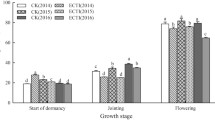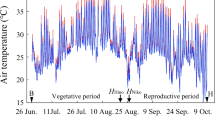Abstract
Temperature and CO2 are two of the main environmental factors associated with climate change. It is generally expected that elevated [CO2] will increase crop production. However, other environmental factors such as temperature along with management practices could further modify a crop’s response to CO2. The goal of this study was to determine the interactive effects of elevated [CO2] and above-optimum temperature on growth, development and yield of two peanut (Arachis hypogaea L.) cultivars, e.g., Pronto and Georgia Green. One of the objectives was to determine if there was any variation in response between these two cultivars with respect to possible adaptation to climate change. Peanut plants were grown in controlled environment chambers in the University of Georgia Envirotron under conditions of non-limiting water and nutrient supply. Plants were exposed to day/night air temperatures of 33/21°C (T A), 35.5/23.5°C (T A + 2.5°C), and 38/26°C (T A + 5°C) along with CO2 treatments of 400 and 700 μmol CO2 mol − 1 air. The selected range of temperatures was based on the temperatures that are common for southwest Georgia during the summer months. The results showed that LAI of both cultivars responded positively, e.g., 28.3% for Pronto and 49.3% for Georgia Green to elevated [CO2]. Overall, elevated [CO2] alone resulted in a significant increase in total biomass at final harvest across all temperatures (P < 0.0001), but decreased final seed yield (P < 0.0005), except for Georgia Green at (T A + 5°C). The higher temperatures compared to T A reduced the relative response of total biomass to CO2 for both cultivars. It can be concluded that final seed yield response to CO2 depends on the sensitivity of individual cultivars to temperature, especially during the reproductive development stage.
Similar content being viewed by others
References
Ahmed FE, Hall AE, Madore MA (1993) Interactive effects of high temperature and elevated carbon dioxide concentration on cowpea [Vigna unguiculata (L.) Walp]. Plant Cell Environ 16:835–842
Allen LH Jr, Bisbal KJ, Boote KJ, Jones PH (1991) Soybean dry matter allocation under subambient and superambient levels of carbon dioxide. Agron J 83:875–883
Atkinson D (1996) Temperature, plant development and crop yields. Trends Plant Sci 1:119
Baker JT (2004) Yield responses of Southern US rice cultivars to CO2 and temperature. Agric For Meteorol 122:129–137
Baker JT, Allen LH Jr (1993) Contrasting crop species responses to CO2 and temperature: rice, soybean, and citrus. In: Rozema J, Lambers H, Van de Geijn SC (eds) CO2 and biosphere. Elsevier, Amsterdam, pp 239–260
Baker JT, Allen LH Jr, Boote KJ, Jones PH (1989) Response of soybean to air temperature and carbon dioxide concentration. Crop Sci 29:98–105
Banks DJ, Kirby JS (1983) Registration of pronto peanut (Reg. No. 28). Crop Sci 23:184
Bannayan M, Hoogenboom G, Crout NMJ (2004) Photothermal impact on maize performance: a simulation approach. Ecol Model 180:277–290
Bannayan M, Kobayashi K, Kim HY, Liffering M, Okada M, Miura S (2005) Modeling the interactive effects of atmospheric CO2 and N on rice growth and yield. Field Crops Res 93:237–251
Bell MJ, Wright GC, Harch G (1993) Environmental and agronomic effects on the growth of four peanut cultivars in a sub-tropical environment. II Dry matter partitioning. Exp Agric 29:491–501
Boote KJ (1982) Growth stages of peanut (Arachis hypogaea L.). Peanut Sci 9(1):35–40
Boote KJ, Allen LH Jr (1999) Effects of elevated carbon dioxide and temperature on growth and yield of peanut. The American Peanut Research and Education Society, Inc. Conference Proceeding vol. 31. p 5
Branch WD (1996) Registration of ‘Georgia Green’ peanut. Crop Sci 36:806
Chen JJ, Sung JM (1990) Gas exchange rate and yield responses of Virginia-type peanut to carbon dioxide enrichment. Crop Sci 30:1085–1089
Clifford SC, Stronach IM, Mohamed AD, Azam-Ali SN, Crout NMJ (1993) The effects of elevated atmospheric carbon dioxide and water stress on light interception, dry matter production and yield in stands of groundnut (Arachis hypogaea L.). J Exp Bot 44(269):1763–1770
Cox FR (1979) Effects of temperature treatment on peanut vegetative and fruit growth. Peanut Sci 6:14–17
Craufurd PQ, Prasad PVV, Summerfield RJ (2002) Dry matter production and rate of change of harvest index at high temperature in peanut. Crop Sci 42:146–151
Cure JD, Rufty TW, Israel DW (1989) Alterations in soybean leaf development and photosynthesis in a CO2-enriched atmosphere. Bot Gaz 150:337–347
Ellis RH, Craufurd PQ, Summerfield RJ, Roberts EH (1995) Linear relations between carbon dioxide concentration and rate of development towards flowering in sorghum, cowpea, and soybean. Ann Bot 75:193–198
Greenberg DC, Williams JH, Ndunguru BJ (1992) Differences in yield determining processes of groundnut (Arachis hypogaea L.) genotypes in varied drought environments. Ann Appl Biol 120:557–566
Hall AE (1992) Breeding for heat tolerance. Plant Breed Rev 10:129–168
Heinemann AB, Maia AHN, Neto DD, Ingram KT, Hoogenboom G (2005) Soybean (Glycine max (L.) Merr.) growth and development response to CO2 enrichment under different temperature regimes. Eur J Agron 24(1):52–61
Horie T, Baker JT, Nakagawa H, Matsui T (2000) Crop ecosystem responses to climatic change: rice. In: Reddy KR, Hodges HF (eds) Climate change, plant productivity and global implications. CABI, New York, NY, pp 81–106
Ingram KT, Hoogenboom G, Liu L (1998) A multidisciplinary research facility for the study of interacting environmental stresses on plants, ASAE Paper No. 984151, St. Joseph, American Society of Agricultural Engineers
IPCC (1995) In: Houghton JT, Meira Filho LG, Callander BA, Harris N, Kattenberg A, Maskell K (eds) The science of climate change, 1996. Cambridge University Press, Cambridge, p 572
Johannessen MM, Mikkelesen TN, Nersting LG, Gullord M, von Bothmer R (2005) Effects of increased atmospheric CO2 on varieties of oat. Plant Breed 124:253–256
Johnson IR, Thornley JHM (1985) Temperature dependence of plant and crop processes. Ann Bot 55:1–24
Jolliffe PA, Ehret DL (1985) Growth of bean plants at elevated carbon dioxide concentrations. Can J Bot 63:2021–2025
Kim HY, Lieffering M, Kobayashi K, Okada M, Miura S (2003) Seasonal changes in the effects of elevated CO2 on rice at three levels of nitrogen supply: a free air CO2 enrichment (FACE) experiment. Glob Chang Biol 9:826–837
Kimball BA, Kobayashi K, Bindi M (2002) Responses of agricultural crops to free-air CO2 enrichment. Adv Agron 77:293–368
Long SP (1991) Modification of the response of photosynthetic productivity to rising temperature by atmospheric CO2 concentrations: has its importance been underestimated? Plant Cell Environ 14:729–739
Matsui T, Namuco OS, Ziska LH, Horie T (1997) Effects of high temperature and CO2 concentration on spikelet sterility in indica rice. Field Crops Res 51:213–219
Morison JIL, Lawlor DW (1999) Interactions between increasing CO2 concentration and temperature on plant growth. Plant Cell Environ 22:659–682
Mortley DG, Philip A, Loretan JH, Seminara J (1997) CO2 enrichment influences yields of ‘Florunner’, ‘Georgia Red’ and ‘New Mexico’ peanut cultivars. Adv Space Res 20:1905–1908
Moya TB, Ziska LH, Namuco OS, Olszyk D (1998) Growth dynamics and genotypic variation in tropical, field-grown paddy rice (Oryza sativa L.) in response to increasing carbon dioxide and temperature. Glob Chang Biol 4:645–656
Newton PCD, Clark H, Bell CC, Glasgow EM, Campbell BD (1994) Effects of elevated CO2 and simulated seasonal changes in temperature on the species composition and growth rates of pasture turves. Ann Bot 73:53–59
Nigam SN, Nageswara JC, Wynne JH, Williams MF, Nagabhshanam GVS (1994) Effect and interaction of temperature and photoperiod on growth and partitioning on three groundnut (Arachis hypogaea L.) genotypes. Ann Appl Biol 125:541–552
Ong CK (1984) The influence of temperature and water deficits on the partitioning of dry matter in groundnut. J Exp Bot 35:746–755
Parton WJ, Logan JA (1981) A model for diurnal variation in soil and air temperature. Agric Meteorol 23:205–216
Prasad PVV, Craufurd PQ, Summerfield RJ (2000) Effect of high air and soil temperature on dry matter production, pod yield and yield components of groundnut. Plant Soil 222:231–239
Prasad PVV, Boote KJ, Hartwell L, Allen JR, Thomas JMG (2002) Effects of elevated temperature and carbon dioxide on seed-set and yield of kidney bean (Phaseolus vulgaris L.). Glob Chang Biol 8:710–721
Prasad PVV, Boote KJ, Hartwell L, Allen JR, Thomas JMG (2003) Super-optimal temperatures are detrimental to peanut (Arachis hypogaea L.) reproductive processes and yield at both ambient and elevated carbon dioxide. Glob Chang Biol 9:1775–1787
Prasad PVV, Allen JR, Boote K (2005) Crop responses to elevated carbon dioxide and interaction with temperature: grain legumes. J Crop Improve 13(1/2):113–155
Reddy KR, Prasad PVV, Kakani VG (2005) Crop responses to elevated carbon dioxide and interactions with temperature: cotton. J Crop Improve 13(1/2):157–191
SAS Institute (2001) SAS system. 8th ed. SAS Inst., Cary, N.C.
Stronach IM, Clifford SC, Mohamed AD, Singleton-Jones PR, Azam-Ali SN, Crout NMJ (1994) The effects of elevated carbon dioxide, temperature and soil moisture on the water use of stands of groundnut (Arachis hypogaea L.). J Exp Bot 45:1633–1638
USDA Peanut Crop Germplasm Committee (2003) Report on the status of Arachis germplasm in the United States. http://www.ars-grin.gov/npgs/cgc_reports/status11.pdf
Vu JCV (2005) Acclimation of peanut (Arachis hypogaea L.) leaf photosynthesis to elevated growth CO2 and temperature. Environ Exp Bot 53:85–95
Wheeler TR, Chatzialioglou A, Craufurd PQ, Ellis RH, Summerfield RJ (1997) Dry matter partitioning in groundnut exposed to high temperature stress. Crop Sci 37:1507–1513
Ziska LH, Namuco O, Moya T, Quilang J (1997) Growth and yield response of field-grown tropical rice to increasing carbon dioxide and air temperature. Agron J 9:45–53
Author information
Authors and Affiliations
Corresponding author
Rights and permissions
About this article
Cite this article
Bannayan, M., Tojo Soler, C.M., Garcia y. Garcia, A. et al. Interactive effects of elevated [CO2] and temperature on growth and development of a short- and long-season peanut cultivar. Climatic Change 93, 389–406 (2009). https://doi.org/10.1007/s10584-008-9510-1
Received:
Accepted:
Published:
Issue Date:
DOI: https://doi.org/10.1007/s10584-008-9510-1




